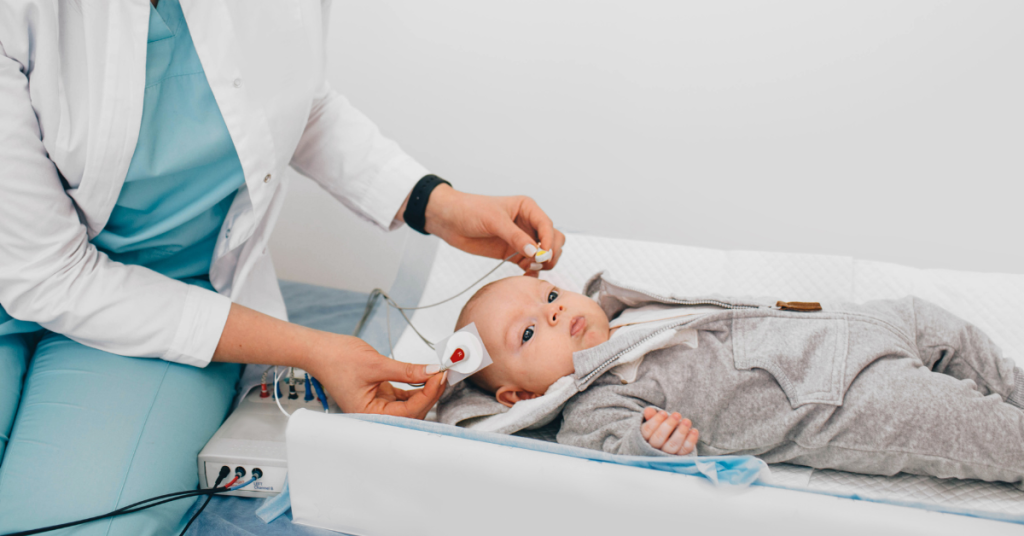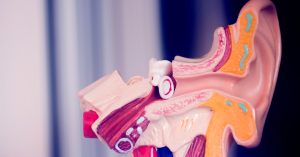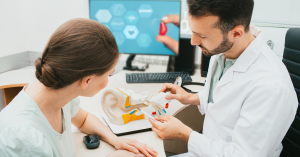Hearing is a complex process that involves not just the ears, but also the brain’s ability to interpret sound signals. When there’s a disruption anywhere along this pathway, it can impact how well we hear and understand the world around us. That’s where the Auditory Brainstem Response (ABR) test comes in—a specialized diagnostic tool designed to evaluate how sound travels from the ear to the brainstem.
The ABR test plays a crucial role in identifying certain types of hearing loss and neurological issues, particularly when traditional hearing tests can’t provide enough information. It’s especially useful for evaluating newborns, individuals with developmental challenges, or patients with unexplained auditory symptoms. But when exactly is this test needed, and what can it reveal?
In this article, we’ll explore the situations in which an ABR test is recommended, who benefits from it, and what the testing process involves. Whether you’re a concerned parent, an adult noticing changes in your hearing, or a caregiver seeking clarity, understanding the role of ABR testing can provide peace of mind and a pathway to better hearing health.
What Is an ABR Test and How Does It Work?
The Auditory Brainstem Response (ABR) test is a non-invasive diagnostic tool that measures how the auditory nerve and brainstem respond to sound. Unlike standard hearing tests that rely on a person’s ability to react to tones or spoken words, the ABR test examines the electrical activity generated by the auditory pathway in response to auditory stimuli. This makes it particularly useful for patients who cannot reliably communicate or respond, such as infants, individuals with developmental delays, or those under anesthesia.
How the Test Works
During an ABR test, small electrodes are placed on the patient’s scalp and earlobes or forehead. These electrodes are similar to those used in an EEG (electroencephalogram) and are painless. Once in place, the patient wears earphones through which a series of clicking sounds or tone bursts are played. As the sounds are delivered, the electrodes detect the brain’s response to the stimuli—specifically the waves produced as sound travels from the cochlea (inner ear) through the auditory nerve and into the brainstem.
The responses are recorded on a computer as waveforms. Each wave corresponds to activity at different points along the auditory pathway. A trained audiologist or neurologist reviews these waveforms to determine if the signals are strong, timely, and symmetrical between ears.
Objective and Reliable
One of the major benefits of the ABR test is that it does not require active participation from the patient. This makes it especially valuable in pediatric audiology and in situations where cognitive or physical challenges prevent traditional testing methods. It’s also used in medical cases where accurate assessment of the auditory pathway is critical for diagnosing conditions like auditory neuropathy or retrocochlear disorders (such as acoustic neuromas).
The ABR test provides a detailed snapshot of the integrity of the auditory system from the ear up to the brainstem, helping clinicians pinpoint the source of hearing issues or neurological delays. In some cases, it can even detect hidden hearing loss that doesn’t show up on standard audiograms.
Common Reasons for Recommending an ABR Test
While routine hearing tests often suffice for evaluating basic hearing ability, there are specific situations where more in-depth analysis is needed—and that’s when the ABR test becomes essential. This advanced test provides insight into how well sound signals travel from the ear to the brain, revealing problems that can’t be detected through standard methods. Physicians and audiologists may recommend an ABR test in a variety of clinical scenarios.
When Hearing Loss Is Unexplained or Sudden
One of the most common reasons for an ABR test is unexplained hearing loss, particularly when it occurs suddenly or without an obvious cause. When a patient reports rapid hearing decline—especially if it affects only one ear—doctors may suspect a retrocochlear disorder such as an acoustic neuroma (a benign tumor on the auditory nerve). The ABR test can detect abnormal nerve responses that indicate a disruption in the neural transmission pathway.
For Patients Who Cannot Complete Traditional Hearing Tests
ABR testing is often used for patients who are unable to complete conventional audiometric tests. This includes:
- Newborns and infants, who cannot communicate or respond to sounds on command
- People with developmental delays or cognitive impairments, who may have difficulty understanding or following test instructions
- Patients under sedation or anesthesia, such as during intraoperative monitoring
Because the ABR does not require any voluntary response, it’s a reliable method for assessing hearing even when cooperation isn’t possible.
Detecting Auditory Neuropathy Spectrum Disorder (ANSD)
Some individuals have hearing loss that originates not from the inner ear itself, but from the auditory nerve or brainstem. This condition, known as auditory neuropathy, affects how sound is processed after it leaves the cochlea. A traditional hearing test may show normal results, while the person still experiences significant hearing difficulties—especially with speech understanding. The ABR test is a critical tool for identifying this condition, as it reveals whether the nerve is transmitting signals accurately.
Monitoring Neurological Function
In some cases, an ABR test is used to monitor neurological status, such as in patients with head trauma, multiple sclerosis, or brainstem lesions. Changes in the timing or strength of ABR waveforms can provide valuable clues about the health of the brain’s auditory processing centers.
Follow-Up After a Failed Hearing Screening
For newborns or children who do not pass their initial hearing screening, an ABR test is often the next step. It helps confirm whether a hearing loss exists, how severe it is, and what part of the auditory system is affected. Early detection is key to timely intervention and language development.
ABR Testing for Newborns and Infants
Hearing plays a vital role in a child’s early development, particularly in learning language and communication. For this reason, early hearing assessment is critical—and the Auditory Brainstem Response (ABR) test is one of the most reliable tools available for evaluating hearing in newborns and infants. Since these young patients can’t verbally respond to sound or follow instructions, the ABR test provides an objective way to determine whether their auditory system is functioning properly.
Why Newborn Hearing Screening Matters
Most hospitals now perform newborn hearing screenings shortly after birth as part of standard care. These screenings typically use either Automated ABR (AABR) or Otoacoustic Emissions (OAE) tests. If a baby does not pass the initial screening, follow-up testing is crucial to determine the cause and extent of any potential hearing loss.
Failing a screening doesn’t always mean a child is deaf or has permanent hearing loss. There can be many temporary factors—such as fluid in the ear canal or mild congestion—but a diagnostic ABR test can provide the detailed data needed to confirm or rule out a true hearing issue.
When Is an ABR Test Recommended for Infants?
An ABR test may be recommended for infants if:
- They fail the initial newborn hearing screening in one or both ears
- There are risk factors for hearing loss, such as a family history, premature birth, or NICU stay
- They exhibit delays in speech or responsiveness to sound
- They have been diagnosed with a genetic condition known to impact hearing
In these cases, the ABR test allows specialists to measure how sound signals travel from the ears to the brainstem, identifying not only the presence of hearing loss but also its type (sensorineural vs. conductive) and severity (mild to profound).
The Testing Experience
For infants, the ABR test is typically done while the baby is asleep or in a very relaxed state. In fact, natural sleep is ideal for capturing clean results, since muscle movement can interfere with readings. If necessary, the child may be mildly sedated under careful medical supervision. The test is completely painless, involving only the placement of soft electrodes on the scalp and playing soft clicking sounds through tiny earphones.
Early Intervention Matters
If hearing loss is confirmed, early intervention is critical. Studies show that children who receive appropriate hearing aids, cochlear implants, or other support before 6 months of age have significantly better outcomes in language and cognitive development than those diagnosed later. The ABR test is often the first step in this life-changing journey, helping families take action early.
ABR Testing in Adults: When Is It Needed?
While ABR testing is often associated with infants and young children, it also plays a critical role in adult hearing care. For adults, the Auditory Brainstem Response (ABR) test is typically used when standard hearing tests are inconclusive or when there’s concern about more complex auditory or neurological conditions. It serves as a powerful diagnostic tool that goes beyond measuring how well someone hears—focusing instead on how sound signals are processed by the auditory nerve and brainstem.
Sudden or Unexplained Hearing Loss
One of the most urgent scenarios where ABR testing is used in adults is sudden sensorineural hearing loss (SSNHL). When a person experiences rapid loss of hearing—especially in one ear—it could signal underlying problems in the auditory nerve or brainstem. The ABR test helps identify whether the sound signals are being transmitted properly or if there’s a blockage or disruption along the pathway.
If the ABR shows abnormal waveforms, this can suggest nerve damage or even a tumor compressing the auditory pathway, prompting further imaging such as an MRI.
Screening for Acoustic Neuroma and Other Tumors
A common reason for referring adults for an ABR test is the suspicion of an acoustic neuroma, also known as a vestibular schwannoma. This is a benign tumor that grows on the vestibulocochlear nerve, which carries sound and balance signals from the inner ear to the brain. Symptoms like unilateral (one-sided) hearing loss, tinnitus (ringing in the ear), or dizziness can prompt an ABR to detect abnormalities in nerve function.
Although an MRI is the gold standard for diagnosing tumors, ABR testing can serve as a screening tool to determine whether further imaging is warranted.
Evaluation of Auditory Processing Disorders
In adults who struggle to understand speech—especially in noisy environments—but show normal results on standard hearing tests, an ABR test may help uncover subtle issues in the neural processing of sound. These cases may involve auditory neuropathy or central auditory processing disorders, which are often missed by basic audiometric evaluations.
Neurological Monitoring and Assessment
Beyond hearing, the ABR test is also used in broader neurological assessments. It can be helpful in patients with multiple sclerosis, brainstem stroke, or traumatic brain injury, as it assesses the integrity of neural pathways. Some surgeons even use ABR monitoring during procedures that risk impacting the auditory nerve, such as brain surgery, to prevent permanent damage.
Hearing Loss with Other Symptoms
If hearing loss is accompanied by dizziness, imbalance, or facial numbness, an ABR test may be part of a comprehensive work-up to evaluate cranial nerve function. These symptoms can indicate serious conditions that require immediate attention.
In summary, ABR testing in adults is not just about detecting hearing loss—it’s about identifying why the loss is occurring and where in the auditory system the problem lies. It allows clinicians to differentiate between peripheral and central causes, helping to guide treatment decisions or referrals to neurology or ENT specialists.
What to Expect During an ABR Test
If you’ve been referred for an Auditory Brainstem Response (ABR) test, you might feel uncertain about what the process involves. Fortunately, the test is safe, painless, and non-invasive, and understanding what to expect can help ease any anxiety. Whether the test is for you, a loved one, or a child, knowing the steps involved can make the experience smoother and more reassuring.
Preparing for the Test
ABR testing requires very little preparation. However, there are a few things to keep in mind:
- Hair and scalp should be clean and free of oils or hair products, as this can interfere with electrode adhesion.
- You may be asked to avoid caffeine before the test, especially if sedation will be used, as caffeine can affect sleep and test results.
- Adults and older children are encouraged to be relaxed or even asleep during the test, as movement can interfere with data collection. In infants and toddlers, the test is ideally performed during natural sleep or with mild sedation if necessary.
For adults, the entire test is typically conducted while seated or lying comfortably in a reclined chair or on a hospital bed.
The Testing Process
Once you’re ready, the technician or audiologist will:
- Clean areas on the forehead and earlobes or scalp, where small, sticky electrodes will be placed. These electrodes detect the brain’s response to sound.
- Place soft earphones in your ears that will deliver clicking sounds or tone bursts at varying volumes and frequencies.
- Instruct you to relax and remain still. You don’t need to respond to the sounds—the equipment will do the listening for you.
The test typically lasts between 30 minutes to 1 hour, depending on how much data needs to be collected and how still or asleep the patient remains. You won’t feel any discomfort; the test simply records your body’s natural electrical responses to sound.
Understanding the Results
After the test, an audiologist or physician will analyze the waveforms produced by your brain’s response to the sounds. Each waveform corresponds to a specific part of the auditory pathway—from the cochlea to the brainstem. The results can show whether:
- The auditory nerve is functioning correctly
- There’s a delay in neural transmission
- One ear is responding differently than the other
Depending on the findings, the ABR test can help diagnose auditory neuropathy, hearing loss, or retrocochlear disorders such as tumors on the auditory nerve. In some cases, it’s used to confirm results from other hearing assessments or determine the need for further imaging.
After the Test
There’s no recovery time needed after an ABR test. Most people can return to their usual activities immediately unless sedation was used—in which case, someone should accompany the patient home, and rest is advised for the remainder of the day.
For parents, receiving ABR results about their baby can be emotional. Regardless of the outcome, the ABR provides crucial information that can open the door to early intervention, therapy, or treatment plans tailored to the child’s needs.
Conclusion
The Auditory Brainstem Response (ABR) test is a powerful diagnostic tool that plays a vital role in understanding the health of our auditory system. Whether used for a newborn who didn’t pass an initial hearing screening, an adult experiencing sudden hearing loss, or someone with symptoms pointing to a neurological condition, the ABR test provides clear, objective insight into how sound travels from the ear to the brain.
Unlike standard hearing tests, the ABR measures the actual electrical activity along the auditory nerve and brainstem, allowing healthcare providers to detect issues that might otherwise go unnoticed. It’s especially valuable in cases where a patient cannot actively participate in testing—such as infants, individuals with cognitive challenges, or those under anesthesia. It also serves as a critical screening tool for identifying conditions like auditory neuropathy, acoustic neuromas, and central auditory processing disorders.
For those undergoing the test, the experience is simple and non-invasive. Knowing what to expect—gentle sound stimuli, painless electrodes, and no need for active responses—can ease worries and make the process less intimidating. And most importantly, the results of an ABR test can guide early intervention, treatment, and management plans that significantly improve quality of life.
If you or a loved one has been referred for an ABR test, take comfort in knowing that it is a safe and effective way to uncover the root cause of hearing or balance issues. As with any health concern, the earlier a problem is identified, the better the outcomes—and the ABR test is a key step in that journey toward better hearing and overall well-being.
FAQ
What does an ABR test detect?
An ABR test detects how well sound signals travel from the ear to the brainstem. It can identify hearing loss, nerve transmission problems, auditory neuropathy, and potential tumors on the auditory nerve. It also helps in assessing brainstem function in neurological evaluations.
Is an ABR test painful or uncomfortable?
No, the ABR test is completely painless and non-invasive. Small electrodes are placed on the skin to detect brain activity in response to sound. Patients simply rest or sleep during the test while listening to soft clicking sounds through earphones.
How long does an ABR test take?
The test typically takes between 30 minutes to 1 hour. The duration can vary depending on the patient’s cooperation, the number of ears tested, and whether sedation is used.
Why does my baby need an ABR test after failing a hearing screening?
Failing a newborn hearing screening doesn’t necessarily mean permanent hearing loss. The ABR test is used to confirm whether a hearing problem exists, determine its severity, and guide early intervention if needed. It is a crucial step in diagnosing and supporting your baby’s hearing health.
Can adults benefit from ABR testing?
Absolutely. Adults may need an ABR test if they experience sudden or unexplained hearing loss, have symptoms suggesting an acoustic neuroma, or show signs of neurological issues affecting hearing. It is also used when standard hearing tests are inconclusive or when central auditory processing disorders are suspected.
This article is for informational purposes only and is not a substitute for professional medical advice, diagnosis, or treatment. If you are concerned about your hearing or ear health, please consult a qualified healthcare provider.






